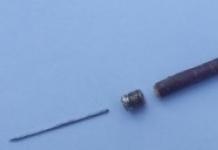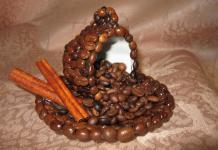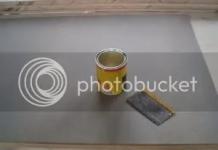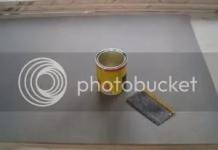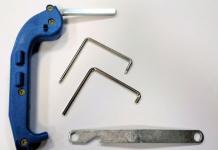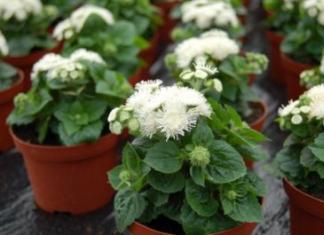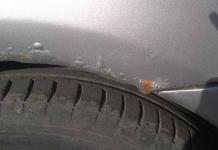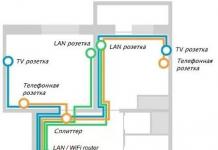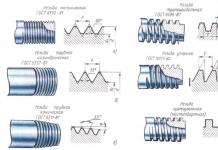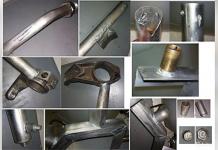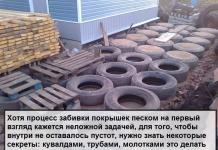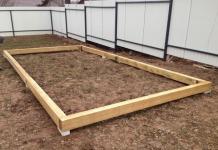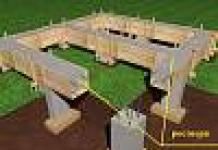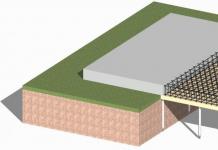Thread is one of the main types of fastening of metal pipes, which can be reproduced independently. So, further we will consider which tool for threading pipes should be purchased, and how to use it. But before that, it is worth deciding on the basic concepts, without which the execution of work will be impossible.
What should you know about carving?
When installing shutoff valves, a transition tee or a coupling on a metal pipe, a thread is made without fail, which is characterized by the following parameters:- depth- distance from the base of the thread to the end of the pipe.
- Profile and its angle- cross-section at the coil, which is made in the form of a triangle, rectangle and other shapes. When the side edges of the turns intersect, an angle is formed.
- step by step- the distance that is formed between the tops of the pipe or nearby coils.
Important: The larger the pitch, the greater the depth and the number of turns per 1 unit. threads and therefore vice versa.
The definition of the profile and pitch should be treated with the utmost attention, since the type of thread depends on this:
- Inch- is represented as a triangle and is used when assembling elements of a water pipe, and sometimes - a heating one.
- Cylindrical- a variant of the inch thread, which has a smaller pitch. The smoothed upper edge of the profile resembles a cylinder. An example of an external cylindrical thread scheme is shown below:
- Conical- the view allows you to get a hermetic connection, which is especially important when using sealing materials.
- Metric- the view is used for branch pipes of small diameters. It can be trapezoidal - the outer corner is made at 30 degrees, and the sides of the coil resemble a trapezoid. For bolted connections, a rectangular thread can also be used, since it makes the fixation more reliable. Here is a diagram of a metric thread, which looks like an equilateral triangle:

Preparing for hand carving
Basic rules of use:- it is recommended to clean the pipe at the place of threading from paint, dirt and rust (only metal should remain);
- if the pipe has a chamfer, you need to carefully remove it with a file (or grinder, if you have the skill to work with this tool);
- during operation, the surface of the pipe and the cutter must be lubricated with a special substance (it must be smeared both at the beginning of work and in the process).
If these rules are not followed, then the life of the tools is sharply reduced, and there is also a great chance to reject or simply break the pipe itself.
Step-by-step instructions for threading with a die
A die for threading pipes looks like a hardened steel nut, inside of which there is a hole in the form of a flower, the edges closest to the center are covered with sharp cutting surfaces, and the “petals” allow the chips to be easily removed without interfering with work.
Working with the tool is not difficult:
- Firmly install the pipe vertically. It must also be prepared - cleaned of paint, chamfers, etc. A ratchet for cutting pipe threads holds a handle of a suitable size, and you spread grease on the pipe.
- Place the plate strictly perpendicular to the pipe. If there is a deviation of at least 5-10 degrees, then the pipe will already be damaged.
- Start moving the handle of the holder clockwise.
- When the desired space is covered with threads, lift the cutter up and go down the already cut one again so that the notches are clearer.

This video is a demonstration of the correct use of the plate. Visual actions follow after the preparatory steps listed above:
Remember to periodically lubricate the cutter and pipe. Act smoothly and calmly. Do not jerk the plate while working and do not leave the process unfinished.
Threading set for pipes and how to use it
An ideal option for home use is a pipe threading kit. Klupp is a modernized die that has a special guide and ratchet. Tools in a set can be different, for example:- Sliding. As a rule, they consist of incisors, the distance between which can be adjusted. Allows you to cut threads in several approaches, accurately and efficiently.
- Monolithic. The tool has a cylindrical shape with an internal hole and is installed in a die holder. Allows you to make a carving in one go.
Kits and individual components vary greatly in price and quality. There are budget options for sets for 1000 - 1100 rubles, but there are much higher ones.
Depending on the diameter of the pipe and the direction of the thread (right, left), a lerka is selected. The workflow then looks like this:
- klupp is installed in a ratchet;
- oil is applied to the cutting part;
- a guide is installed on the edge of the pipe;
- the ratchet spins, making a thread;
- in the course of work, the edges and the pipe are treated with oil.

It is necessary to change the screw cap in time - it must always be sharp, and all other elements must be in good order.
An example of threading with a screw plug is shown in the video:
Threading a pipe near a wall
You may have a situation where you need to make a thread on a pipe that is already built into the wall. The principle of operation in this situation is exactly the same as described above. However, there is a big “but”: the device needs space to work, so you may have to remove part of the wall. An example of such work is shown in the video:Important! The cut on the pipe must be made perfectly even, otherwise it will be extremely difficult to cut the thread.
How to cut an internal thread?
To manually make an internal thread, taps inserted into the knobs are used. They consist of three parts:- Fence. Used directly when cutting;
- Calibrating. The middle part is necessary for guiding when sizing and cutting;
- Tail. The part has a square head and is used to hold the tap in the wrench when cutting.
Gutter cutting machine
A machine for cutting threads on pipes is unlikely to be needed by a person who equips his home. It's more of a working tool. By design, it is somewhat reminiscent of vertical drilling machines.The workpiece diameter and cutting pitch are adjustable. The operation of the spindle can be carefully debugged by adjusting the number and speed of revolutions. In principle, such a machine does almost all the work. Also, unlike manual lerok, the machine can make not only external threads, but also internal ones. More modern devices can process the smallest parts and products with thin walls.
In the following video, you can clearly see how the machine works without distortions:
Video: Manual threading in a country workshop
In the next video, the master will tell you in detail what needs to be considered for competent threading, and how to do the job correctly:The above describes in detail all the main stages of work that both a beginner and a seasoned master need to know when cutting threads. However, if you understand that you are not succeeding in this process, and you need to continue the repair, it is best to contact a professional master.
When performing a variety of repairs that are associated with the restoration of water supply elements, the replacement of plumbing fixtures, heating registers, and others, it is necessary to use parts of metal pipelines with threaded sections. In this article we will tell you how to cut a thread on a pipe yourself. If you know the features of cutting and stock up on the appropriate tool, then this task will be completed by you properly and relatively quickly.
since time immemorial, for threading on tubular elements, not metric, but the so-called inch thread has been used, which differs from a simple one in a different thread profile angle (55? versus 60? for metric). In addition, the inch thread has a smaller pitch value, which is explained by the small thickness of the pipe wall.
A small stroke indicates that there will be more threads on the same length of the threaded part. Accordingly, the reliability of the connection also increases.
Carving is not uncommon right and left. At the right thread, the turns, when viewed from the end part of the product, go to the right, and accordingly, at the left - to the left. Right-hand thread is used much more often.
It is very easy to find out which thread on one of the threaded sections: if, when screwing the joined element, it turns clockwise, it means that the thread is right-handed.

On a water pipe, the direction of the turns does not matter, because the products do not rotate at the end of the connection, but remain stationary. In addition to the pipe thread in the joints, they also use a fastening thread, in which the stroke is larger. It is performed on holes and hardware for them.
Methods for threading pipes

It is possible to cut the threads on water pipes with your own hands using two tools - a die (it is also called a lerka) and a klupp. What is the difference between them?
The die is a hand-held thread-cutting tool, the outer side of which has a seat under the body in the form of two opposite grooves. And the inner side is a grooved insert with a threaded hole for chip removal, reproducing the pitch and diameter of the required thread. At the end of the threaded profile there are so-called runaway sections. They serve a dual purpose: they provide ease in centering sections of two pipes before they are joined, and they improve the flow of chips generated during threading. The designation of the thread diameter is applied on the end surface of the die. For cutting, the die is inserted into a crank body, equipped with removable handles for turning the die, and fixed with screws.

How to properly cut a thread with a die? It is better if the pipe to be cut is securely and evenly fixed in a bench vise. The slightest misalignment will cause the thread to be cut with a slope. This will weaken the pipe wall and skew the entire connected section of the plumbing or plumbing system.
In order to ensure a reliable direction, go to make a small revision of the die. To do this, a guide sleeve is welded to one of the ends of the die, which must, with a small gap (no more than 0.2–0.4 mm), enter the pipe where the thread is cut. The length of the guide sleeve must be at least several thread diameters.
Klupp is a more experienced thread-cutting tool (on sale in most cases it is not uncommon to have a set of several die cutters of different diameters). The fundamental difference between the screw die is that its dies are sliding and are made up of four halves, so they can be adjusted to thread threads of various diameters, but in one step. When pushing the die on the pipe section, the dies are brought to the surface and fixed in the desired position. The adjustment of the relative placement of the detachable dies of the die is done by moving its intent-washer.

The threaded screw die already has a guide element in its design, based on this, there will be no skew of the thread being cut when it is used.
A more practical type of klupp is considered to be a ratchet, which has a ratchet mechanism in its design. Threading is performed not by rotational, but by rocking movements of the handles with simultaneous feeding of the die. Klupp is indispensable if you want to cut a thread on a pipe without removing it from the pipeline section.
Cutting development

The sequence of threading a pipe consists of the following steps:
- They clean the desired section of the pipe from rust, other irregularities and paint stains of the outer diameter of the pipe.
- Abundantly lubricate the required section of the pipe with engine oil or sulfofresol, due to which the load on the handle during cutting will be much less. The same can be done for the plate/plates.
- Securely fix the pipe in a vise. Along with this, the end of the pipe protruding for threading should not be more than 5–8 of its diameters, otherwise the accuracy of cutting is not guaranteed. Dies with a guide bushing or screw plugs do not require such restrictions.
- The pipe is prepared for cutting, for which a lead-in cone with a height of at least half the height of the die is acquired with a file. At this point, a running section of the thread is formed, if this is critical, then it can then be removed with a hacksaw.
- They put on a die or klupp, and, vigorously rotating the knob, acquire the desired threaded section. be guided not to forget that the length of the cut section of the thread should be a couple of turns more than required. For fidelity, it is possible to drive the die along the cut section a couple of times.

So, if you start following the recommendations and instructions proposed in the article, you can quickly and properly cut the thread on the pipe. Do you have questions on the topic? Then ask questions by writing a comment on the article.
Any owner of a city apartment or a private house thinks about the improvement of his home. In such a situation, the owner of the premises must have good tools and certain skills.
Die - a tool for cutting threads by handThis article talks in detail about how to cut a thread on a pipe with your own hands - how to cut a thread with a tap by hand.
What is carving for?
A groove in the form of a screw with a constant pitch and section, which is applied to bolts, screws and nuts.
The main parameter of such a threaded connection is the diameter, which is considered in inches, and the number of turns cut along the length of an inch (1 inch is 25.4 mm).
In home improvement, cylindrical inch pipe threads are more often used.
As a result, when connecting a metal tube to a plastic one, the owners of private houses in everyday life often use only a threaded connection. In such a situation, you can easily cut the thread.
In addition, pipe products with inch threads are used in the repair of water pipes and the installation of segments of the heating system.
Such tubular products are used when ordering residential design elements. In a similar situation, on one of the components of the interior of the room.
When installing a washing machine, threading is also done on pipes.
Working with an electric threader
Along with modern household electrical appliances, the owners of residential premises use an electric threader. Such a tool is more often used when threading is done on small tubular products.
In the kit of such a device there is a lerka for cutting threads of various diameters and an electric thread cutter itself.
When clamping a piece of tubular product, a pipe vice is used. In such a situation, locksmiths pull the trigger, after which an inch conical thread is cut into the tubular product.
When cutting threaded connections on tubes, rapid heating or overheating of the power threader can occur.
However, such risks do not arise if installers process 1 pipe part. In such a situation, as a rule, it does without the use of this expensive power tool.
An electric threader makes it much fasterIf an external thread is cut on an inch pipe product, then in such a situation, you should carefully use an electric threader. Using this large tool, it is not always possible to cut threaded connections on tubular products that are close to the wall.
- plate holder;
- a die for draft threaded connections (through passage);
- die for fine threaded connections (finish);
- grease;
- a piece of lard, oil from a barrel of a car;
- grinder, file.
When cutting a tube, not 1, but 2 dies are used, because it is easier to cut the tube this way. In such a situation, the service life and technical characteristics of the tool itself increase.
In whatever place the owner of the dwelling is engaged in cutting pipe threaded connections: on water pipes or on pipes of the heating system, he must first check the condition of the pipes.
If such a check is not carried out before starting work, then when cutting threaded connections, the tube will quickly break.
When manually cutting pipes, fitters perform the following actions:
- first, chamfer is removed - at the end of the tubular product, where the threaded sections of the tube will be located;
- further, lubricant is applied to such sections of the tube and the teeth of the die;
- then, the die holder, on which the pass-through die is fixed in advance, is strongly pressed against the tubular, resulting in engagement;
- then the locksmiths rotate the tool clockwise - they cut the threaded connection in 5 turns.
If in such a situation there is some resistance, then the installers make a half turn back. As a result, the sawdust will break off and making turns clockwise is easier.
When carrying out such work, a finishing die is used, which is pre-lubricated. Installers perform the same actions as in the implementation of rough cutting.
It is forbidden to cut threaded connections on tubes at a fast pace. External cutting of threaded sections on tubular products must be done at a slow pace, while making movements with the tool half a turn forward.
You can cut threads on pipes of any diameterAccording to professionals in this business, when threading tubes, it is better to use expensive, but expensive and durable dies.
The difference between them is visible visually. At the same time, when using a cheap die, it is possible to make a strong pipe threaded connection over a short period of time - after repeated use of such a tool, the applied external thread does not have the required depth.
Also, when manually cutting threaded connections, in addition to dies, locksmiths use die cutters to cut pipes.
What is klupp?
Many novice locksmiths have no idea what a pipe cutting screw is. Many of them have never used such a tool.
In order to imagine what it looks like, you need to know what an ordinary die looks like (a lerk for cutting pipes). This tool has the following details:
- a small cylinder based on tool steel;
- slot for sawdust;
- recess - around the circumference, with which the die is clamped in the die holder;
- combs for internal cutting of threaded connections.
Klupps are die cutters - the main part of the tool. Locksmiths fix such cutters in a holder, which is a guide.
The main advantages of the klupp over the die
The main advantages of a pipe die over a die are:
- The die for cutting external threads is made of durable and expensive steel, which is used in the manufacture of various tools. However, only the cutters with which the locksmiths cut the threaded connection on the tube should have great strength;
- a pipe die is a die in which there are no expensive and non-functional parts. Reliable cutters and an inexpensive holder - everything you need to perform high-quality cutting of a threaded connection on tubes;
- when using a klupp, locksmiths save consumables.
However, there is one drawback to this tool - threading screws are expensive tools. Currently, they sell such pipe clamps, the price of which reaches $ 1,000. At the same time, it must be remembered that the cutters are a replaceable part of such a device.
Pipe clamps are expensive tools, however, they make the job of a plumber easier.
WATCH VIDEO
Taps
Thread taps are screws.
Threading with a tap is done by cutting grooves in the chip.
This tool has a shank, which is fixed on a wrench or machine.
Taps have various sizes, types and numbers.
When cutting threaded connections on a tube, locksmiths use a set of 2 taps that have different cutting depths - for roughing and finishing work, respectively.
Despite the widespread dominance of polypropylene pipes, metal plumbing and heating systems are still in demand.
This means that when laying steel pipelines, you will need devices for their processing. One such tool is a threading screw. With its help, work on pipes is carried out quickly, and with professional quality.
What tools are used to cut external pipe threads?
The list is not great:
- Lathe.
- Klupp mechanical or electric.
- Dash (aka lerka).
In addition to the file, you will need a lathe or lerka. This is no joke: in industrial conditions, coils are really cut using a machine. Especially if pipe threading occurs inside.
On the outer surface, machining is also possible if the workpiece is not too long. The use of a die on the machine is undesirable (although possible), a cutter is used for threading.
The advantage of the lathe: it is the only external threading tool that can correctly form the conical shape of the joint. No manual threading set will be able to consistently increase the diameter of each next turn.

This type of cutting, after tightening, creates a strong and airtight joint, which works on the principle of a Morse taper. The disadvantage of a lathe is obvious: not everyone has such a machine at home. The maximum mechanization is a portable electric screw cap.

Even 20 years ago, when a normal tool was in short supply, home locksmiths actively used ordinary dies. A thread cutting screw could be borrowed for a short time, and it was taken to process pipes already laid along the walls.
The die (unlike the klupp) was entirely made of hardened alloy steel, regularly performed its work as part of 2-3 pass-through sets: each next number cuts ever deeper turns.

With the help of a klupp or die (in everyday life - "lerki"), only a cylindrical thread is cut. It allows you to adjust the length of the joint, but does not provide tightness without sealing materials.

Actually, what is a klupp, and how does it differ from lerki?
The die (lerka) is a monolithic structure. On the one hand, this allows you to cut threads with high precision. The reverse side of the coin is the large diameter (and, accordingly, the circumference) of the pipe creates a huge load.
Threaded connections are used in the manufacture of a wide variety of products. This is due to the fact that it can be cut independently using inexpensive equipment. Before applying coils to the surface of the product, you should consider the main points regarding certain parameters. A high-quality thread is characterized by a tight connection and high reliability. Let us consider in more detail the process of cutting coils on pipes.
Preparing for hand carving
Threading pipes at home can be done using improvised tools. The basic rules for preparation are as follows:
- At the place where the coils are cut, dirt, rust and other pollutants are removed. This recommendation is due to the fact that foreign elements can degrade the quality of the turns.
- If there is a chamfer on the pipe, then it is carefully removed with a file. In some cases, this process is carried out by a grinder, but the quality of the resulting chamfer may be low. Therefore, if there is no need to rush, then it is best to work with a file.
- At the time of work, the surface must be well lubricated with oil. Only in this case it is possible to ensure the smooth running of the mechanism used.
Step-by-step instructions for threading with a die
The most common can be called a die of various types. It is one of the necessary tools for cutting coils. Among its features, we note the following points:
- The die looks like a nut made of hardened steel. From the end sides there are holes made in the form of a flower. To ensure machining, the edges are represented by sharp cutting edges. Due to the petal shape, chip removal from the cutting zone is ensured.
- There are holes in the body for mounting the handle. They are located on the sides, due to which a uniform impact is ensured.
The die has become widespread due to the fact that it is quite easy to use. Recommendations for its use are as follows:
- At the time of processing, the pipe must be vertically located. At the same time, it is fixed with a vice.
- It is recommended to clean the surface, as well as create a chamfer.
- Oil should be applied to the pipe, which will simplify the passage of the die through the pipe.
- It should be borne in mind that the die must be located strictly vertically. Even with a deviation of only 10 degrees, it will lead to a decrease in the quality of the resulting turns.
- The handle should be rotated clockwise.
- In order to improve the quality of the resulting surface, one reverse should be done after two turns, which ensures the removal of metal residues from the cutting part.
During work, periodically lubricate the working part and the pipe with oil. Lubricants make cutting easier and smoother.
Threading set for pipes and how to use it
You can significantly simplify the task of threading by purchasing a special set for pipes. It is ideal for home use. An example is a klupp - a slightly modified die, which is used together with a ratchet and a guide. The kit may include various devices:
- Monolithic are represented by a cylindrical body with an internal hole. For work, a special die holder is also included in the kit.
- Sliding ones consist of incisors, the distance between which can be adjusted if necessary. It is used for cutting a threaded surface in several passes, thereby improving the quality.
Lerka is selected depending on the diameter of the pipe and the direction of the thread. The cutting process is characterized by the following features:
- A special tool, called a klupp, is installed in a ratchet.
- Oil is also applied to the cutting part, which simplifies the movement of the working part.
- A guide is installed on the edge of the processed pipe.
- The ratchet rotates around the axis, due to which the thread is formed.
- During machining, oil is added from time to time.
It is worth considering the moment that the device after prolonged use may become dull. That is why you need to monitor the condition of the cutting edge.
Threading a pipe near a wall
Most of the problems arise with threading on a pipe that is located near the wall. This is due to the location of the workpiece and the lack of free space. That is why a common question can be called how to cut a thread on a pipe.
In this case, processing is carried out using similar tools. However, threading a pipe near a wall is often only possible if the wall is partially removed. Among other features of the procedure, we note the following points:
- If you need to cut a thread on one of the sections of the pipeline, then it is recommended to dismantle it first. In some cases this is possible.
- For cutting pipe threads, a fairly large amount of oil is also required, which facilitates the movement of the device. However, when the pipe is horizontal, it begins to drain quickly, which creates significant problems with the process under consideration.
- The thread is made in several passes, which ensures a high surface quality.
Cutting a thread on a water pipe when it is in a horizontal position is quite difficult. This is due to the fact that it is quite difficult to control the strict location of the applied mechanism parallel to the axis, as well as to provide the required load.
How to cut an internal thread?
In some cases, an internal thread is required, which can also be cut using a hand tool. Often, for such work, a tap is selected, which consists of three main parts:
- Fence.
- Calibrating.
- Tail.
The intake is applied directly at the moment of cutting, the calibrating guides the tool and ensures its vertical position. The tail section is required in order to fix the die in a special holder.
An internal thread can be formed as follows:
- The pipe is fixed in a vertical position.
- The tap workpiece is lubricated.
- The device is placed strictly vertically, after which several rotations are made clockwise, and one against.
At the time of work, oil should be added from time to time. This ensures a smooth running of the tool.
Gutter cutting machine
In production, special machines are often used. In terms of design features, they are in many ways reminiscent of machines with a vertical orientation. Among the features we note:
- Diameter index and thread pitch are adjustable.
- If necessary, you can carefully adjust the number and speed of rotation of the cutting element.
- Almost all models are characterized by the possibility of processing the outer and inner surfaces.
Modern machines can be used even when cutting thin-walled products. Difficulties can arise only when the workpiece cannot be removed and installed vertically.
Basic cutting methods
There are two main ways to cut coils on the surface to be treated: manually or using automatic equipment. In home workshops, hand tools are often used, as they are cheap and easy to use. The most commonly used die, on sale are the following:
- Klupp.
- Whole.
- Split.
The main part of the fixture can be made in the form of a square and hexagons. The most widespread are disk versions, which are used for threading.
Split or spring-loaded versions are characterized by high wear resistance. However, the features of their design determine that it is practically impossible to achieve high accuracy and purity of the cut turns.
You can also use sliding dies, which often consist of two working parts. This ensures versatility in application.
Thread cutting technique
As previously noted, the klupp is represented by a modernized die, which has adjustable cutters. In addition, the cutting part can be replaced if necessary and extend the life of the tool.
On sale you can find a manual version, as well as an electric one. Hand tools are more common, they are easy to use and inexpensive.
Electric are characterized by high performance. Klupp is installed in a different position, but most often in a vertical position.
Cutting with a hand screw
- The working part is installed in a special holder made in the form of a ratchet. It greatly simplifies the process of cutting coils on the surface of the pipe.
- You can start work by cleaning the pipe. It should be borne in mind that when cutting turns, it is possible only in the absence of strong defects.
- Surface cleaning is carried out to the metal until it begins to shine.
- The outer edge is machined to obtain a chamfer. This ensures the entry of the tool.
- The surface is treated with technical vaseline. It reduces the degree of friction, makes the tool run smoother.
- The pipe is fixed in a vice, you can hold it with a gas wrench. It is important to exclude the possibility of tilting or displacement of the pipe when a high load is applied to it.
The work involves making several turns clockwise, and then in the opposite direction. This is done in order to remove chips from the cutting zone.
Cutting with an electric screw
In addition to hand tools, electric tools are also widely used. The advantage of this embodiment can be called high performance. Work with its application has the following features:
- The part to be processed is carefully prepared.
- Provides reliable fastening of the workpiece.
- The mechanism is fixed at the starting point.
- The free movement of the guides and the direction of rotation of the cutting part are checked.
- The first turns are cut in jog mode.
On the tool, you can set the basic parameters, for example, the length of the cut. Application features depend on its functionality and other operational characteristics.
The procedure for cutting external threads on a water pipe
Water pipes are found in almost every residential and commercial building. The sequence of actions for threading is as follows:
- Preparation. At the preparatory stage, the main thing is to remove all dirt and possible rust, as well as remove all defects. Otherwise, it may be difficult to carry out the work.
- Workpiece installation. The pipe must be located strictly vertically, otherwise the die may move to the side.
- Cutting. At this stage, it is necessary to monitor the strictly vertical arrangement of the mechanism used, since even a slight displacement can lead to significant problems.
- Quality checking. This stage involves screwing the nut, due to which the cleanliness of the turns and the accuracy of their location are checked.
When using a lathe, it is possible to create turns in one longitudinal pass. However, screw-cutting lathes are not the best suited for the task at hand.
On stainless pipe
Often, stainless steel is used in the manufacture of pipes. It is characterized by high strength and corrosion resistance. However, the presence of a large amount of alloying elements leads to a decrease in the degree of machinability. That is why there can be quite a few difficulties with threading.
You can simplify the cutting process with the abundant use of a lubricant. In addition, you need to choose a die or tap made of wear-resistant material that will not dull during processing.
In conclusion, we note that it is not necessary to have any skills or have special tools to obtain threads on the surface of pipes. It is important to use the selected threading mechanism correctly, as well as monitor the presence of lubricant. It should be borne in mind that an insufficient amount of lubricant can lead to jamming of the die or tap.


